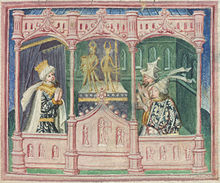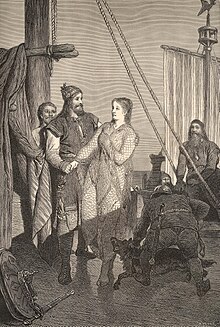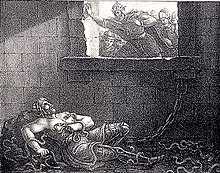Ragnar Lodbrok
| Ragnar Lodbrok | |
|---|---|
 Lothbrocus and his sons Hyngwar and Ubba. 15th century miniature in Harley MS 2278, folio 39r. | |
| Father | Sigurd Hring[1] |
| Mother | Álfhildr Gandálfsdóttir of Álfheimr[1] |


Ragnar Lodbrok or Lothbrok (Old Norse: Ragnarr Loðbrók, "Ragnar Shaggy-Breeches") was a legendary[2][3] Viking hero and ruler, known from Viking Age Old Norse poetry and sagas. According to this traditional literature, Ragnar distinguished himself by many raids against Francia and Anglo-Saxon England during the 9th century.
According to the antiquarian Hilda Ellis Davidson, writing in 1980, "certain scholars in recent years have come to accept at least part of Ragnar's story as based on historical fact".[4] On the other hand, the historian Katherine Holman wrote in 2003 that "although his sons are historical figures, there is no evidence that Ragnar himself ever lived, and he seems to be an amalgam of several different historical figures and pure literary invention."[5]
Sources and historicity
According to traditional sources, Ragnar was:
- son of the Swedish king Sigurd Hring and a relative of the Danish king Gudfred;
- married three times, to the shieldmaiden Lagertha, the noblewoman Thóra Borgarhjǫrtr and Aslaug (also known as Kráka, Kraba and Randalin), a Norse queen;
- the father of historical Viking figures including Ivar the Boneless, Björn Ironside, Halfdan Ragnarsson, Hvitserk, Sigurd Snake-in-the-Eye and Ubba;[5]
- captured by King Ælla of Northumbria and died after Ælla had him thrown into a pit of snakes, and;
- avenged by the Great Heathen Army that invaded and occupied Northumbria and adjoining Anglo-Saxon kingdoms.[5]
The most significant medieval sources that mention Ragnar include:
- Book IX of the Gesta Danorum, a 12th-century work by the Christian Danish chronicler Saxo Grammaticus,
- the Tale of Ragnar's sons (Ragnarssona þáttr), a legendary saga,
- the Tale of Ragnar Lodbrok, another saga, a sequel to the Völsunga saga,
- the Ragnarsdrápa, a skaldic poem of which only fragments remain, attributed to the 9th-century poet Bragi Boddason, and
- the Krákumál, Ragnar's death-song, a 12th-century Scottish skaldic poem.
As a figure of legend whose life only partially took place in times and places covered by written sources, the extent of Ragnar's historicity is not quite clear.
In her commentary on Saxo's Gesta Danorum, Davidson notes that Saxo's coverage of Ragnar's legend in book IX of the Gesta appears to be an attempt to consolidate many of the confusing and contradictory events and stories known to the chronicler into the reign of one king, Ragnar. That is why many acts ascribed to Ragnar in the Gesta can be associated, through other sources, with various figures, some of which are more historically certain. These candidates for the "historical Ragnar" include:
- King Horik I (d. 854),
- King Reginfrid (d. 814), a king who ruled part of Denmark and came into conflict with Harald Klak,
- the Reginherus who besieged Paris in the mid-9th century, and
- possibly the Ragnall (Rognvald) of the Irish Annals.[4]
So far, attempts to firmly link the legendary Ragnar with one or several of those men have failed because of the difficulty in reconciling the various accounts and their chronology. Nonetheless, the core tradition of a Viking hero named Ragnar (or similar) who wreaked havoc in mid-ninth-century Europe and who fathered many famous sons is remarkably persistent, and some aspects of it are covered by relatively reliable sources, such as the Anglo-Saxon Chronicle.
In popular culture
Ragnar Lodbrok features prominently in:
- Edwin Atherstone's novel Sea-Kings in England;
- Edison Marshall's 1951 novel The Viking;
- Richard Parker's 1957 historical novel The Sword of Ganelon explores the character of Ragnar, his sons, and Viking raiding culture;
- a 1958 film, The Vikings based on Marshall's novel, in which Ragnar, played by Ernest Borgnine, is captured by King Ælla and cast into a pit of wolves; a son named Einar [sic], played by Kirk Douglas, vows revenge and conquers Northumbria with help from half-brother (and sworn enemy) Eric (played by Tony Curtis), who also had much to avenge upon King Aella.
- Harry Harrison's 1993 alternative history novel The Hammer and the Cross depict Ragnar being shipwrecked, captured and executed, as well as his sons' revenge;
- various strategy video games with a historical setting, including Civilization III: Play the World, Medieval: Total War, Civilization IV: Warlords,' 'Age of Empires II: The Forgotten and Crusader Kings II;
- History Channel's historical drama television series Vikings as the protagonist, played by Travis Fimmel.
Footnotes
- ^ a b Sögubrot 1200.
- ^ Magnusson 2008, p. 106.
- ^ Harrison 1993, p. 16.
- ^ a b Davidson 1980, p. 277.
- ^ a b c Holman 2003, p. 220.
References
- Saxo Grammaticus (1980) [1979]. Davidson, Hilda Roderick Ellis (ed.). Gesta Danorum. Vol. 1 & 2. Translated by Peter Fisher. Cambridge: D. S. Brewer. Chapter introduction commentaries. ISBN 978-0-85991-502-1.
{{cite book}}: Unknown parameter|trans_title=ignored (|trans-title=suggested) (help) - Harrison, Mark (1993). "Viking Hersir 793-1066 AD". Osprey Publishing. ISBN 978-1-85532-318-6.
{{cite journal}}: Cite journal requires|journal=(help); Invalid|ref=harv(help) - Holman, Katherine (2003). Historical dictionary of the Vikings. Lanham, Maryland: Scarecrow Press. ISBN 978-0-8108-4859-7.
{{cite book}}: Invalid|ref=harv(help) - Magnusson, Magnus (2008). The Vikings: Voyagers of Discovery and Plunder. Osprey Publishing. ISBN 978-1-84603-340-7.
{{cite book}}: Invalid|ref=harv(help) - Sögubrot af nokkrum fornkonungum. c. 1200.
Further reading
- McTurk, Rory (1991). Studies in Ragnars saga loðbrókar and Its Major Scandinavian Analogues. Medium Aevum Monographs. Vol. 15. Oxford. ISBN 0-907570-08-9.
{{cite book}}: CS1 maint: location missing publisher (link) - Strerath-Bolz, Ulrike (1993). Review of Rory McTurk, Studies in "Ragnars saga loðbrókar" and Its Major Scandinavian Analogues, Alvíssmál 2: 118–19.
- Forte, Angelo, Richard Oram, and Frederik Pedersen (2005). Viking Empires. Cambridge University Press, ISBN 0-521-82992-5.
- Schlauch, Margaret (transl.) (1964). The Saga of the Volsungs: the Saga of Ragnar Lodbrok Together with the Lay of Kraka. New York: American Scandinavian Foundation.
- Sprague, Martina (2007). Norse Warfare: the Unconventional Battle Strategies of the Ancient Vikings. New York: Hippocrene Books. ISBN 0-7818-1176-7.
- Waggoner, Ben (2009). The Sagas of Ragnar Lodbrok. The Troth. ISBN 978-0-578-02138-6.
- 8th-century births
- 9th-century deaths
- Danish legendary figures
- English heroic legends
- Heroes in Norse myths and legends
- Mythological kings of Denmark
- People whose existence is disputed
- Semi-legendary kings of Sweden
- Kings of the Geats
- Viking Age monarchs
- House of Munsö
- Völsung cycle
- 9th-century rulers in Europe
- 9th-century Swedish people
- 9th-century Danish people
